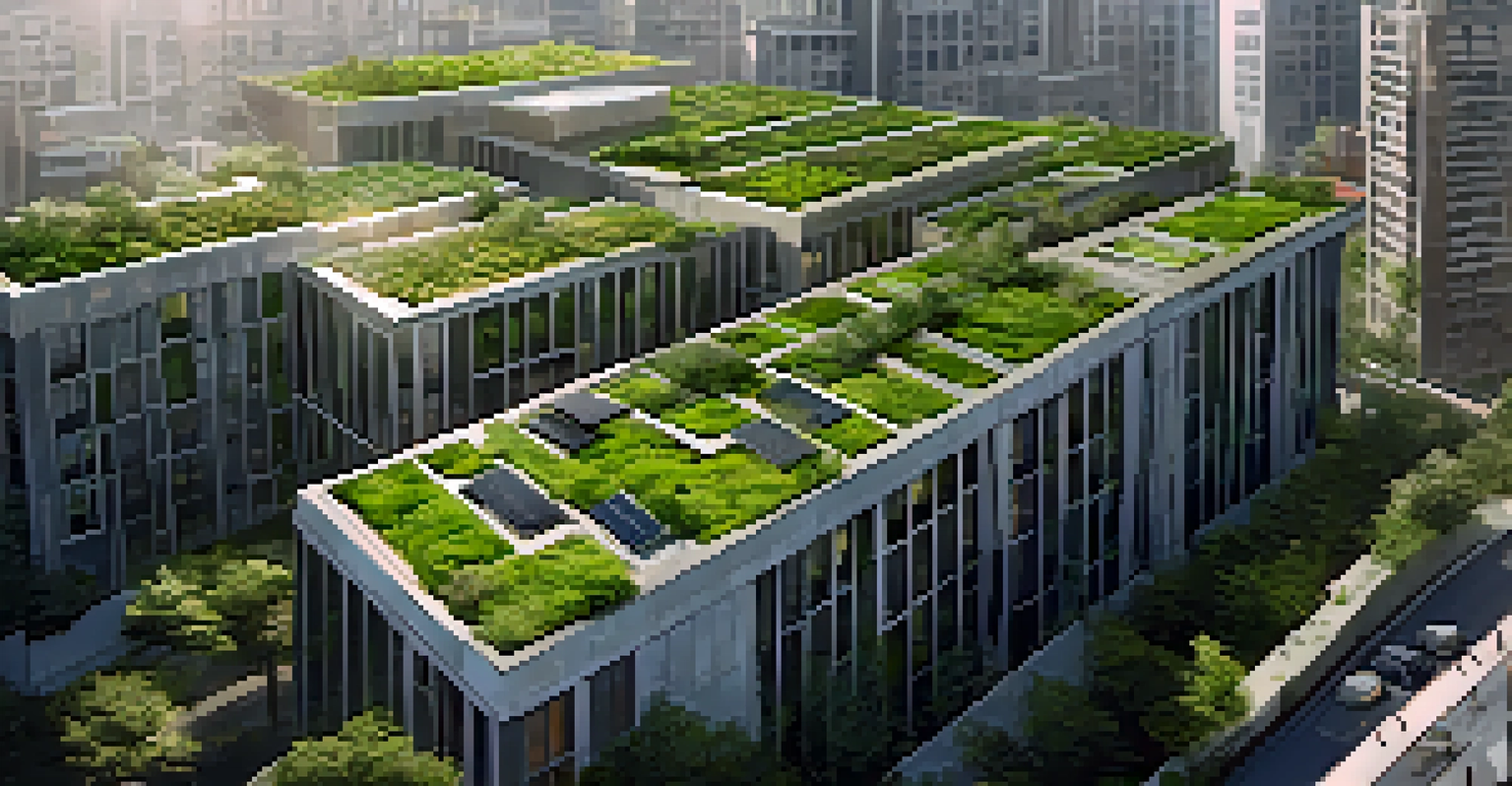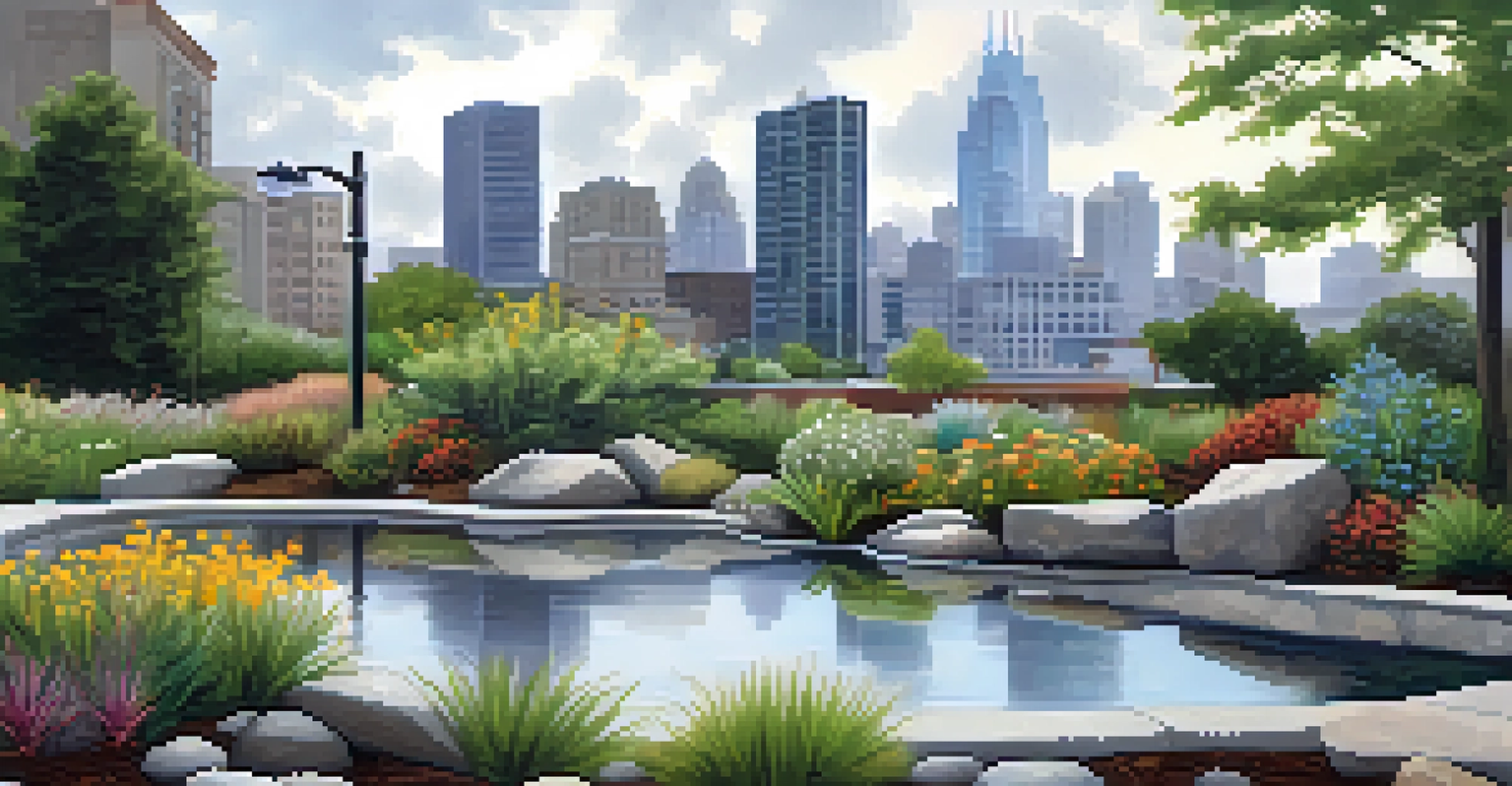How Urban Green Spaces Mitigate Climate Change Effects on Plants

Understanding Urban Green Spaces and Their Importance
Urban green spaces, like parks and gardens, are essential for city ecosystems. They provide a refuge for various plant and animal species, enhancing biodiversity in otherwise concrete-heavy environments. These green areas also contribute to improving air quality, as plants absorb carbon dioxide and release oxygen, which is vital for both humans and wildlife.
Nature does not hurry, yet everything is accomplished.
Moreover, green spaces act as natural temperature regulators. Trees and plants provide shade, helping to cool the surrounding area, which is especially important during heatwaves exacerbated by climate change. This cooling effect not only benefits plants but also helps reduce energy consumption in nearby buildings, leading to lower greenhouse gas emissions.
In essence, urban green spaces are more than just aesthetic additions to cities; they are critical components in the fight against climate change. By understanding their significance, we can better appreciate the role they play in sustaining urban life and combating environmental degradation.
How Green Spaces Help Mitigate Urban Heat Islands
Urban heat islands are areas in cities that are significantly warmer than their rural surroundings due to human activities and infrastructure. Green spaces play a pivotal role in alleviating these temperature disparities by providing shade and increasing evapotranspiration, where moisture is released from plants into the atmosphere. This natural process cools the air, making urban environments more bearable during extreme weather events.

For example, a well-treed park can reduce temperatures by several degrees compared to nearby asphalt-covered areas. This cooling effect not only aids plants in thriving but also supports the health and well-being of urban residents. When people are more comfortable, they are more likely to spend time outdoors, fostering a connection with nature.
Urban Green Spaces Enhance Biodiversity
These areas provide critical habitats for various species, supporting balanced ecosystems that can withstand climate change.
Ultimately, mitigating urban heat islands is crucial for maintaining plant health and urban biodiversity. As climate change continues to challenge our ecosystems, enhancing green spaces becomes a strategic approach to ensuring resilience against extreme temperatures.
Enhancing Biodiversity Through Urban Green Spaces
Biodiversity refers to the variety of life forms in a particular habitat, and urban green spaces are vital for preserving this diversity in cities. They serve as critical habitats for various species, offering food, shelter, and breeding grounds for birds, insects, and other wildlife. This biodiversity is essential for maintaining balanced ecosystems, which can better withstand the impacts of climate change.
The creation of a thousand forests is in one acorn.
For instance, pollinators like bees and butterflies thrive in gardens and parks filled with native plants. By planting diverse flora, urban green spaces can support these important species, which in turn helps plants reproduce and maintain genetic diversity. This interconnectedness between species is what keeps ecosystems resilient, especially as climate conditions shift.
In summary, urban green spaces are not just pretty places to enjoy; they are lifelines for biodiversity. By fostering a diverse range of plants and animals, cities can enhance their ecological health and adaptability in the face of climate change.
Carbon Sequestration: Plants as Climate Change Warriors
One of the most significant benefits of urban green spaces is their ability to sequester carbon. Plants absorb carbon dioxide during photosynthesis, a process that transforms this greenhouse gas into oxygen and biomass. This natural mechanism helps mitigate the effects of climate change by reducing the overall concentration of CO2 in the atmosphere.
For example, a mature tree can absorb around 48 pounds of carbon dioxide annually. In urban settings, where emissions from vehicles and buildings are high, every tree and plant counts in the fight against rising greenhouse gas levels. This is why planting and preserving green spaces in cities is crucial for climate action.
Green Spaces Mitigate Urban Heat
By providing shade and promoting evapotranspiration, urban green spaces help reduce temperature disparities in cities.
In essence, urban green spaces act as carbon sinks, helping to offset emissions and combat climate change. By investing in these areas, we can harness the power of nature to create healthier, more sustainable urban environments.
Stormwater Management and Urban Green Spaces
Urban areas often struggle with stormwater runoff, which can lead to flooding and water pollution. Green spaces play a key role in managing this runoff by absorbing rainfall and allowing it to percolate into the ground, which reduces surface water and helps recharge groundwater supplies. This natural filtration process is vital for maintaining water quality in urban environments.
For instance, rain gardens and permeable pavements in parks can significantly reduce the volume of stormwater that flows into drainage systems. By incorporating these elements into urban planning, cities can mitigate the impacts of heavy rainfall and protect local waterways from contamination. This is particularly important as climate change leads to more intense storms and unpredictable weather patterns.
Ultimately, urban green spaces serve a dual purpose: they enhance aesthetic beauty while also performing critical environmental functions. By effectively managing stormwater, they help protect both plants and urban infrastructure from the adverse effects of climate change.
Promoting Community Engagement with Nature
Urban green spaces are not just ecological assets; they are also vital for fostering community engagement and connection to nature. Parks and gardens provide spaces for recreation, relaxation, and social interaction, allowing residents to immerse themselves in the natural environment. This connection can inspire a greater appreciation for local ecosystems and motivate collective action against climate change.
For example, community gardening initiatives encourage residents to cultivate plants, which not only beautifies the neighborhood but also educates them about the importance of biodiversity and sustainability. Such activities can create a sense of ownership and responsibility toward local green spaces, reinforcing their value in the community.
Effective Policy Supports Green Areas
Sustainable urban planning and policies are essential for integrating and preserving green spaces, ensuring equitable access for all communities.
In summary, urban green spaces serve as vital platforms for community engagement. By fostering a connection between people and nature, they inspire collective efforts to address climate change and promote environmental stewardship.
Policy and Planning for Sustainable Urban Green Spaces
To maximize the benefits of urban green spaces in mitigating climate change effects, effective policy and planning are essential. City planners and policymakers must prioritize the integration of green spaces into urban development projects. This includes not only creating new parks but also preserving existing ones and ensuring equitable access for all communities.
For instance, implementing green infrastructure practices, such as green roofs and vertical gardens, can enhance urban areas while providing much-needed green space in densely populated settings. These innovative solutions help balance the built environment with nature, making cities more resilient to climate challenges.

By prioritizing sustainable urban green space planning, cities can pave the way for a healthier future. Proper policies can ensure that urban environments thrive, fostering both plant life and human well-being in the face of climate change.